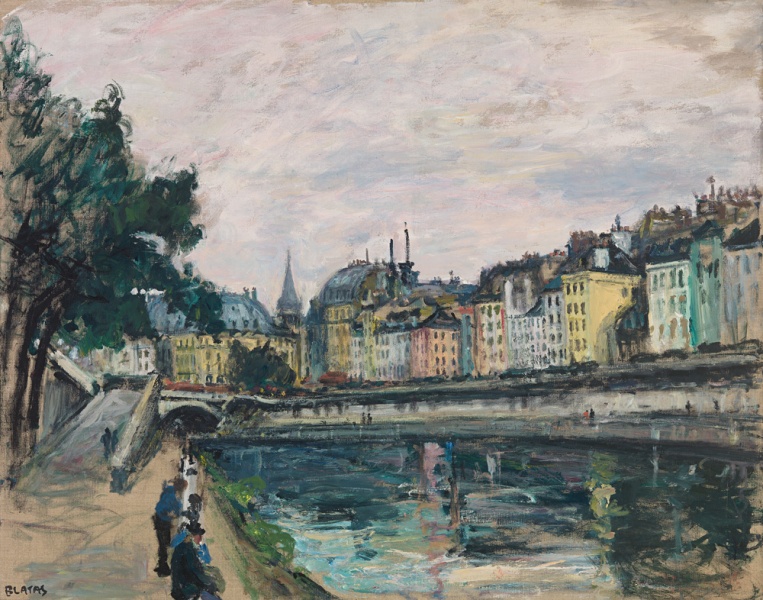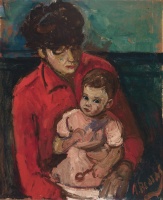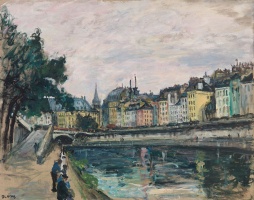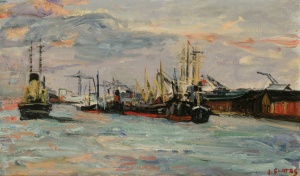


Paris
| Author: |
Neemiya Arbitblatas (1908–1999)  |
| Created: | 1930s |
| Material: | canvas |
| Technique: | oil |
| Dimensions: | 73 × 91.50 cm |
| Signature: | bottom left: BLATAS |
Arbit Blatas was one of the youngest of the Paris school. He arrived in Paris in 1926 to study, but stayed there until 1939. Only when it became dangerous to stay in Europe due to the threat of Fascism did he leave for the USA. He chose Bonnard, Utrillo, Pissaro and Vlaminck as his artistic guides, and was attracted by the vividness of Impressionism, Post-Impressionism and Expressionism. He came to love Paris and its artistic atmosphere, and the city responded with reciprocal appreciation. In 1936, the Jeu de Paume museum bought a picture of his, and later the main galleries of Paris frequently displayed his works.
Arbit Blatas painted the sights of Paris between the wars over and over again, and each time they were different. The pictures varied depending on the mood and the spectrum of colours, for they expressed the painter’s impressions and emotional perception of the scenes. The subject of this picture is a river bank in Paris with rapidly changing light. The manner of painting, in grey shades of rare sublimity, shows the artist as a painter with a lively temperament, sensitive and subtle, and able to match the expressiveness of colour, drawing and various methods of execution.
Text author Nijolė Tumėnienė
Although Arbit Blatas (1908–1999) did not study at Kaunas Art School, he brought new ideas to the Kaunas art scene. He never received a state scholarship, but studied art in Paris at his own expense at the Académie Julian and the Académie de la Grande Chaumiere, and so enjoyed much more freedom in his career. Following the Paris fashion, Blatas opened the first private art gallery in Kaunas, bringing the cultural life of the interim capital closer to the Western way of life. In 1932 and 1933, he put on exhibitions of works by young artists, both Lithuanians and other nationalities (mostly Jewish). He had to close the gallery due to a shortage of money, and left for Paris.
The works by Blatas in the Ellex Valiunas collection can be said to summarise his career. His painting of the banks of the River Seine shows the strong influence of the Paris school,
Text authors Dovilė Barcytė and Ieva Burbaitė
French Expressionism and the École de Paris. In the early 20th century, every young person starting out on a career as an artist dreamt of going to Paris and becoming famous. The large group of Litvaks who migrated there formed the nucleus of the École de Paris. Litvak artists brought Yiddish culture and the shtetl world-view to Paris, which combined with the modern art trends of the time (Post-Impressionism, Cubism, Futurism and Fauvism) and formed a new trend, French Expressionism. This trend was popular between 1915 and 1940, and about 60 Litvaks and more than 150 Jewish painters from all over Europe were adherents of the Paris school.
French Expressionism brought fresh ideas, new motifs and artistic discoveries to art. The trend is characterised by elegance and restrained expression, flat forms, vibrant brushstrokes, light colours, and nuanced painting. The artists were interested in the life around them: views of the city and its squares, people enjoying themselves in cafés, the hustle and bustle of a market, and the razzle-dazzle of carousels and the circus. They painted portraits of their wives and children, streetwalkers and female nudes in studios, apples on windowsills, and flowers in vases.
Text author Vilma Gradinskaitė
Source: Law firm Valiunas Ellex art album THE WORLD OF LANDSCAPES II (2013). Compiler and author Nijolė Tumėnienė, KAUNAS–VILNIUS / 1918–1945 (2021). Compilers and text authors Dovilė Barcytė and Ieva Burbaitė, STORIES OF LITVAK ART (2023). Compiler and author Vilma GradinskaitėExpositions: "1918-1945 / Kaunas-Vilnius", 27 August 2020 – 21 August 2021, Lithuanian Art Centre TARTLE (Užupio St. 40, Vilnius). Curators Dovilė Barcytė and Ieva Burbaitė.









